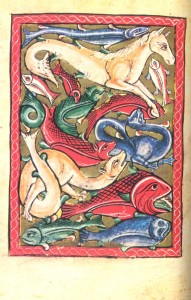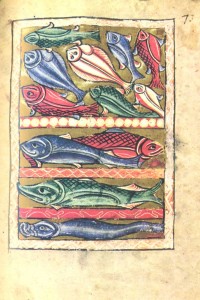
Fishes and sea animals /pisces et animalia marina/ 9.9X13.5; 9.8X13.5 cm
For the most part the vast text about fishes and sea animals is taken from Isidor /XII.VI.I—57/, who classed fishes into species by analogy with animals although the order of Isidor’s story is much more confused. Among fishes and sea animals mention is made of the hypocamps seal, murena, eel, chub, cling-fish, ray, polyp, crab, sea urchin, and oyster. This list was largely extended later in the 13th century by Albert thr Great who mentioned 139 fishes and sea animals /book XXIV/.

The bestiary extols the feelings of compassion, love for children and piety, allegedly typical of fishes, as an example for man to follow. Fish of a different species never mix with one another, he writes, thereby keeping the species pure, in contrast to disgraceful fornication among human beings and to their practice of cross-breeding animals.
The two spectacular miniatures, both the size of a page, show the outlines of fishes and marine creatures against a shining golden background, thus reminding one that “the kingdom of heaven is like unto a net, that was cast into the sea, and gathered of every kind” /Matthew 13:47/. Similar motifs are reproduced by the drawings in the bestiary of the University Library at Cambridge /II.4.26/. Such compositions of marine creatures have a fairly long history, dating back to the motif of the sea kingdom so popular with the ancients of the Mediterranean world beginning with the Crete-Mycenaean epoch. Like in Roman miniatures, fishes, sea snakes and hypocamps lay coiling on the bulging surfaces of antique vases forming decorative designs in antique mosaic and painting.
Fishes and sea animals
You are here:
- Home
- Architecture
- Saint Petersburg
- The Saint Petersburg Public Library
- The Medieval Bestiary
- Fishes and sea animals





